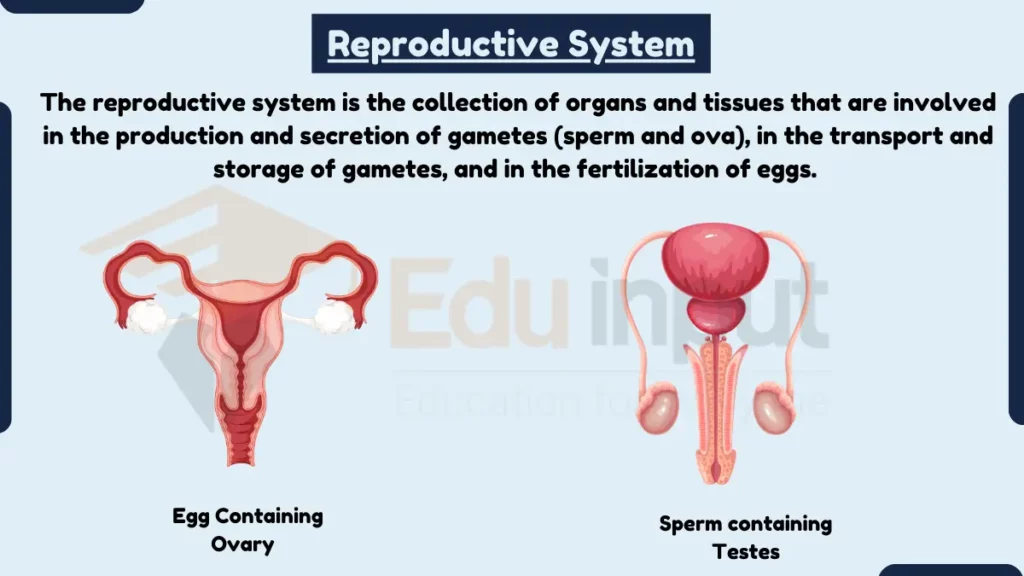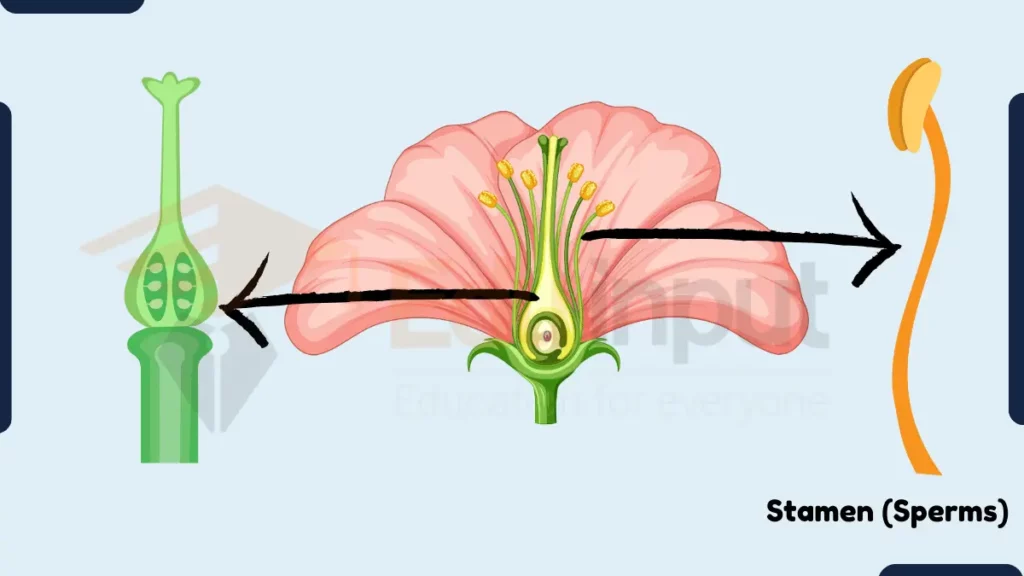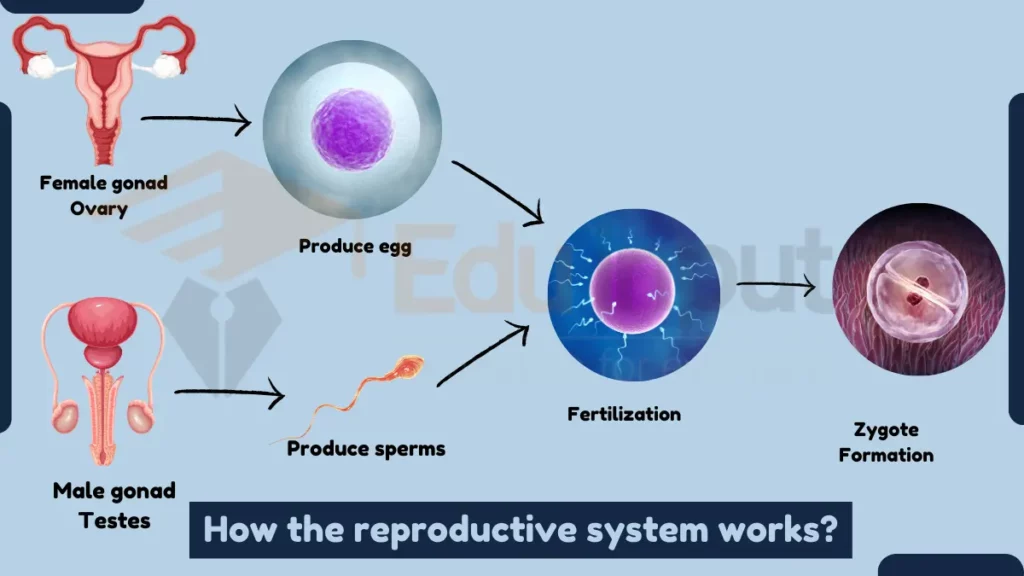Reproductive System-Organs and How it Works?
The reproductive system is the collection of organs and tissues that are involved in the production and secretion of gametes (sperm and ova), in the transport and storage of gametes, and in the fertilization of eggs.
The reproductive system is also involved in development and maintenance of pregnancy and in the production of hormones that regulate sexual development and function.

Reproductive organs in Plants
Plants have followinng reproductive organs that help them to reproduce:
- Stamen – The male reproductive organ of a flower, consisting of an anther that produces pollen (contains sperm cells).
- Pistil – The female reproductive organ of a flower, consisting of the stigma, style, and ovary that contains ovules (eggs cells).

Reproductive organs in Different Animals & Plants
Here are reproductive organs of different animals and plants:
Reproductive organs in Mammals
- Testes -The testes are the male reproductive organs that produce sperm and androgens, including testosterone. Testosterone is responsible for the development of male sex characteristics, such as a deep voice, facial hair, and muscle mass.
- Ovaries – The ovaries are the female reproductive organs that produce eggs and estrogen. Estrogen is responsible for the development of female sex characteristics, such as breasts, hips, and body fat distribution.
- Uterus – The uterus is a muscular organ that supports the development of a fetus during pregnancy. It is lined with an endometrium, which is a thick layer of tissue that provides nutrients and oxygen to the developing fetus.
- Vagina – The vagina is a muscular canal that receives the penis during intercourse and gives birth to the offspring. It is also a passageway for menstrual blood and other fluids.
Read About Male Reproductive System
Reproductive organs in Birds
- Testes – The testes are the male reproductive organs that produce sperm. Sperm are transferred to the female cloaca during mating.
- Ovary – The ovary is the female reproductive organ that produces eggs. Only the left ovary is functional in most birds.
- Oviduct – The oviduct is a tube that transports and stores eggs before laying. It is also the site of fertilization, where the sperm and egg fuse to form a zygote.
- Cloaca – The cloaca is a multi-purpose organ that serves as the passageway for feces, urine, and reproductive fluids. It is also used for egg laying and sperm reception.
Reproductive organs in Reptiles and amphibians
Cloaca is the main reproductive organ of reptiles and amphibians. The cloaca is a multi-purpose organ that serves as the passageway for feces, urine, and reproductive fluids. It is also used for sperm transfer and egg laying.
Reproductive organs in Fish
- Testes – The testes are the male reproductive organs that produce sperm. Sperm are transferred to the female cloaca during mating.
- Ovaries – The ovaries are the female reproductive organs that produce eggs.
- Oviduct – The oviduct is a tube that transports and stores eggs before laying. It is also the site of fertilization, where the sperm and egg fuse to form a zygote.
Reproductive organs in Insects
Insects exhibit a wide range of reproductive diversity, and their reproductive organs can vary greatly in structure and function.
- Testes – The testes are the male reproductive organs that produce sperm. Sperm are transferred to the female during mating through a variety of copulatory organs, such as aedeagus, parameres, and claspers.
- Ovaries – The ovaries are the female reproductive organs that produce eggs. Eggs are stored in receptacles called spermathecae after mating. Fertilized eggs are laid through a tube called the ovipositor.
For example, some male insects have multiple testes, while others have a single testis. Some female insects have paired ovaries, while others have a single ovary. Additionally, the copulatory organs and ovipositor of insects can vary greatly in shape and size.
How the reproductive system works?
The reproductive system is a complex system of organs and tissues that work together to produce offspring. The male and female reproductive systems are different, but they both have the same basic function: to produce gametes (sperm and eggs) and to bring them together so that fertilization can occur.

Gamete production
Gametes are produced in the gonads, which are the reproductive organs. In males, the gonads are called testes and they produce sperm. In females, the gonads are called ovaries and they produce eggs.
Gamete transport
Once gametes are produced, they need to be transported to the site of fertilization. In males, sperm are transported through a series of tubes, including the epididymis, vas deferens, and urethra. In females, eggs are transported through the fallopian tubes.
Fertilization
Fertilization is the process by which a sperm and egg fuse to form a zygote. In most animals, fertilization occurs internally, meaning that it happens inside the female’s body. However, in some animals, such as fish and amphibians, fertilization occurs externally, meaning that it happens in the environment.
Development
Once the zygote is formed, it begins to develop into an embryo and eventually a fetus. The development process varies depending on the species of animal. For example, some animals, such as marsupials, give birth to underdeveloped offspring that continue to develop outside the womb. Other animals, such as placental mammals, give birth to fully developed offspring.
Birth
The process of birth is also known as parturition. It is the process by which the fetus is expelled from the mother’s body. Birth can be a complex and dangerous process, but it is essential for the new offspring to survive.
Also Read:



Leave a Reply